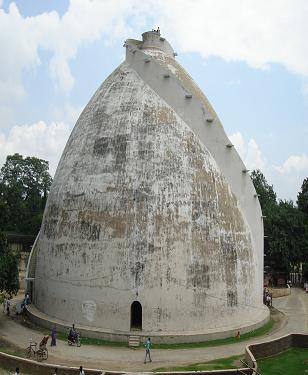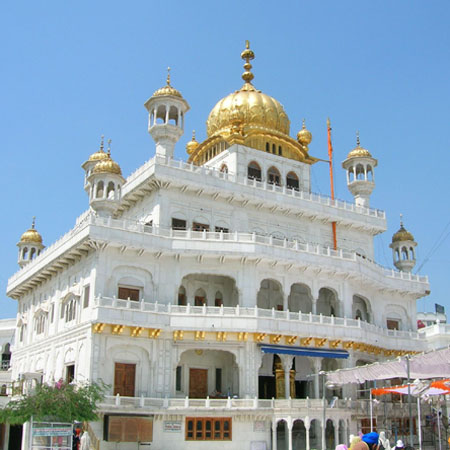
Welcome |
|
|
|
|
|
|
|
|
|
|
|
|
|
|
|
|
|
|
|
|
|
|
|
|
|
|
|
|
|
|
|
|
|
|
|
|
|
|
|
|
|
|
|
|
|
|
|
|
|
|
|
|
|
|
|
|
|
|
|
|
|
|
|
|
|
|
|
|
|
|
|
|
|
|
|
|
|
|
|
|
|
|
|
|
|
|
|
|
|
|
Information about
Patna
|
|
Patna, also known Pataliputra is the capital of Bihar. Pataliputra was known as Pushpapur and Kusumpur in the earlier times, both of them means the city of flowers. Patali also means the trumpet flower. The city of Patna was founded by the Ajatshatru's son, Udayana. To Fa-hien, the Chinese traveler, who visited Pataliputra a century earlier, it looked so magnificent that he thought it must have been built by supernatural beings. Patna is situated at the confluence of Son, Punpun and Ganga rivers. It stretches along the southern banks of Ganga for about 15 km. Patna is also a convenient place to visit Nepal through a land route. Patna can be visited throughout the year, except from April to June, which are very hot. |
|
|
|
|
History of Patna |
|
The history of Patna can be traced back 2500 years ago. The ancient city of Patna was situated on a long strip of land, half a mile to the north of the Kumarhar village. King Ajatashtru, the second Magadha king built a small fort at Pataliputra. Later Chandragupta Maurya founded the Mauryan Empire with its capital at Pataliputra. The Greek ambassador Megasthenes was also impressed by the emperor's administration efficiency and splendour of the city. The Ashok also usurped the throne of his father, Bindusara and started a reign of terror before converting to Buddhists in Patna. Ashok’s palace extended from the mound called Chhoti Pahari to Kumarhar and it covered an area of 4 square miles. Bhikra Pahari, an artificial hill of brick debris, over 40 feet high and about a mile in circuit, on which stood the residence of one of the Nawabs of Patna, is identified as the hermitage-hill built by Ashoka for his brother Mahendra. In the Panchapahari are identified five great relic-stupas built by Ashoka. In the 16th century, the Sher Shah Suri revolted against the Mughal Emperor Humayun, who then ruled the region and established the foundations of new Patna and also built a mosque in 1540 which dominates the skyline. |
|
|
|
|
Tourist Attractions in
Patna |
|
Patna Museum, Jalan Museum, Kumrahar, Golghar, Harmandir Sahib Temple, Saif Khan's Mosque, Khuda Baksh Oriental Library and Sadaquat Ashram are the main tourist attractions in Patna. Martyr’s Memorial, Lakshmi Narayan Mandir, Paschim Daroja, Shahi Masjid and Gandhi Maidan are other places of interest in Patna. |
|
|
Golghar
The Golghar or round house is the extraordinary 29 m high
beee-hive shaped structure which stands between the maidan and the river
Ganga. This house was built in 1786 of stone slabs by Capt. John Garstin of Bengal Engineers as a granary for the British army. The granary has two spiral starcases and has a base of 125 m wide and 3.6 m thick wall. The grain was to be carried up from one side, poured in through the hole at the top and then the workforce was to descend the other staircase to collect more. This granary is now empty, but commands a panoramic view of the River
Ganga, city and its suburbs from the top.
Saif Khan's Mosque
Saif Khan's Mosque, also known as the Pathar-ki-Masjid or Chimni Ghat is situated on the banks of the Ganga. This mosque was built by Prince Parvez, the Mughal Emperor Jahangir’s son in 1621. |
 |
|
|
 |
Harmandir Sahib Temple
Harmandir
Sahib Temple is located in the Chowk area of
Patna. In 1666, the last of the ten Sikh
Gurus, Guru Gobind Singh was born in Harmandir
Sahib. A marble temple was built here by
Maharaja Ranjit Singh. This temple is one of
the four most sacred and pilgrimage centre of
the Sikhs. The temple has kiosks on the
terrace and a museum on the ground floor that
houses photographs, holy scriptures and
personal possessions of the Guru. As a sign of
reverence, it is also called as Patna Sahib by
the Sikhs.
Jalan Museum
Jalan Museum is a private house and was built over the ruins of Sher Shah Suri's fort. This museum can be visited with special permission. The museum contains the Chinese paintings and a valuable collection of jade and silver filigree work of the Mughal period. |
|
|
|
|
Patna Museum
The Patna Museum has excellent collection of bronze images, Chinese and Tibetan antiques, paintings and a 15 meter long fossil tree. It also contains a fine collection of coins, a first World War cannon, terracotta, bronze, metal and stone sculptures including the famous Mauryan Didarganji Yakshi, Jain sculptures, various relics of the Maurya and Gupata period and findings from Bodh Gaya, Nalanda and Kukrihar, belonging to 3rd and 4th centuries B.C.
Kumrahar
Kumrahar is situated 11 km. from the Patna railway station. Excavations done in this village have found the ruins of Pataliputra, enclosed within a high brick wall. These ruins date back to 600 BC to 600 AD. The buildings were devastated by fire and lay hidden in the silt. The more recent fifth phase dates from the beginning of the 17th century. Megasthenes, the Greek ambassador to Chandragupta Maurya’s court also said that the royal palace excelled in splendour and is better than the palaces of the Egyptian, Babylonian and Cretan monarchs. Some of the most important findings are the rare wooden ramparts and a large Mauryan assembly hall with highly polished 80 sandstone pillars belonging from 300 to 400 BC. In the 5th century AD, when the Chinese pilgrim Fa-hien visited the area, he commented on the brilliant enamel-like finish achieved by the Mauryan stone cutters and referred it as the shining bright like a glass.
Khuda Baksh Oriental Library
The Khuda
Baksh Oriental Library is an asset for scholars of
medieval history. The Khuda Baksh Oriental Library has
rich collection of books and rare Persian and Arabic
manuscripts. A number of them are beautifully
laminated. This museum was founded in 1900. It also
contains the Mughal and Rajput paintings and the only
books rescued from the Moorish University of Cordoba
in Spain and an inch-wide Quran. It is now one of the
India's national libraries.
Sadaquat Ashram
The Sadaquat Ashram is the seat of Bharatiya Vidyapith, a national university established in 1921. Its museum displays the personal belongings of India’s first President, Dr. Rajendra Prasad.
Martyrs’ memorial
Martyrs’ memorial is a memorial to seven freedom fighters who sacrificed their lives in “Quit India” movement of August 1942. This museum is a modern sculpture and faces the Secretariat where they were shot in their attempt to hoist the national flag.
Sher Shah Suri Masjid
Sher Shah Suri Masjid was built by Sher Shah Suri in 1545 to commemorate his reign. This mosque is built in Afghan architectural style, and one of the many beautiful mosques in Bihar and a landmark in
Patna. |
|
|
|
|
Excursions |
|
Maner
Maner is situated about 29 km. away to the west of Patna. Maner was one of the earliest Islam centres in Bihar. The famous Sufi Saint, Pir Hazrat Makhadun Yahiya Maneri lived in Maner in the 13th century and thus this place was named after him. His tomb is known as the Badi Dargah and a very special shrine. The Chhoti Dargah is a mausoleum that commemorates the Musilm saint's disciple Shah Daulat. The designs and carvings on the mausoleums are beautiful. The Chhoti Dargah is considered as one of the finest mausoleums in the region. It is an important place of pilgrimage for Muslims during the annual Urs
(fair). |
 |
|
|
|
Sasaram
Sasaram is situated on the main railway line connecting Delhi and Calcutta, about 193 km. from Patna. The mausoleum of Sher Shah, one of the finest building of medieval India is situated here. Sher Shah was the emperor of India from 1539 to 1545 AD. He had planned the building of the mausoleum and also started the construction, but only the last touches were given by his son after his death. The mausoleum stands amidst an artificial lake and the hill in the distant horizon forms an excellent background for the monuments, with reflections in the water adding to its grandeur. |
|
|
|
Sonepur
Sonepur is situated about 22 kms. across the Ganga river, near its confluence with the Gandak river. Sonepur is the place where the famous Sonepur Mela is held on Kartik Purnima, the first full moon after the festival of Diwali in the month of November. This fair is one of the Asia's biggest and month-long cattle fair where elephants, camels, sheeps, birds, handicrafts and handlooms are sold and magic shows, folk dances and contests of skill are also held. The fair attracts a large number of curious foreigners every year. According to the legend, the Sonepur was the site of a battle between the Gaj (elephant), the lord of the forest and Garh (crocodile), the lord of the waterways. |
|
|
|
|
|
How to get
there |
|
By Air:
Patna is well connected by air with all major cities of India like Calcutta, Varanasi, Mumbai, Ahmedabad, Lucknow and Delhi. It is also the nearest airport for the various Buddhist tourist attractions in Bihar.
By Rail:
Patna is a main railway junction and connected with Delhi, Mumbai, Varanasi, Calcutta and many other major cities.
By Road:
Patna is connected by road to Bodh Gaya, Nalanda, Rajgir, Varanasi, Gorakhpur,
etc.
To know the distances
from Patna
click here.
|
|
|